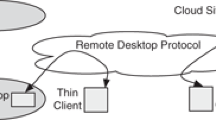Abstract
The Desktop-as-a-Service (DaaS) idiom consists of utilizing a cloud or other server infrastructure to host the user’s desktop environment as a virtual desktop. Typical for cloud and DaaS services is the pay-as-you-go pricing model in combination with the availability of multiple subscription types to accommodate the needs of the users. However, optimal cost-efficient allocation of the virtual desktops to the infrastructure proves to be a combinatorial NP-hard problem, for which a heuristic is presented in the current article. We present a cost model for the DaaS service, from which a revenue of different configurations of virtual desktops to the servers can be derived. In this cost model, both subscription fee and penalties for degraded service are recorded, that are described in service-level agreements (SLAs) between the service provider and the users, and make realistic assumptions that different subscription types result in particular SLA contracts. The heuristic proposed states that for a given user base for which the virtual desktops (VDs) must be hosted, the VDs should be spread evenly over the infrastructure. Experiments through discrete event simulation show that this heuristic yields an approximation within 1 % of the theoretically achievable revenue.


Similar content being viewed by others
References
Buyya R, Shin Yeo C, Venugopal S, Broberg J, Brandic I (2009) Cloud computing and emerging it platforms: vision, hype, and reality for delivering computing as the 5th utility. Futur Gener Comput Systems 25(6):599–616
Anderson DP (2004) Boinc: a system for public-resource computing and storage. In: Grid computing. Proceedings. Fifth IEEE/ACM International Workshop on, pp 4–10. http://boinc.berkeley.edu/
Cappello F, Djilali S, Fedak G, Herault T, Magniette F, Néri V, Lodygensky O (2005) Computing on large-scale distributed systems: XtremWeb architecture, programming models, security, tests and convergence with grid. Futur Gener Comput Systems 21(3):417–437
Microsoft Corporation. Windows Remote Desktop Protocol (RDP). http://msdn2.microsoft.com/en-us/library/aa383015.aspx
Richardson T, Stafford-Fraser Q, Wood KR, Hopper A (1998) Virtual network computing. IEEE Internet Comput 02(1):33–38
Tolia N, Andersen DG, Satyanarayanan M (2006) Quantifying interactive user experience on thin clients. Computer 39(3):46–52
Deboosere L, Vankeirsbilck B, Simoens P, Turck F, Dhoedt B, Demeester P (2012) Efficient resource management for virtual desktop cloud computing. J Supercomput 62(2):741–767
Stillwell M, Schanzenbach D, Vivien F, Casanova H (2010) Resource allocation algorithms for virtualized service hosting platforms. J Parallel Distrib Comput 70:962–974
Vin H, Goyal P, Goyal A (1994) A statistical admission control algorithm for multimedia servers. In: Proceedings of the second ACM international conference on Multimedia, pp 33–40
Boorstyn RR, Burchard A, Liebeherr J, Oottamakorn C (2000) Statistical service assurances for traffic scheduling algorithms. IEEE J Sel Areas Commun 18(12):2651–2664
Weatherford LR, Bodily SE (1992) A taxonomy and research overview of perishable-asset revenue management: yield management, overbooking, and pricing. Oper Res 40(5):831–844
Rothstein M (1971) An airline overbooking model. Transp Sci 5(2):180–192
Liberman V, Yechiali U (1978) On the hotel overbooking probleman inventory system with stochastic cancellations. Manag Sci 24(11):1117–1126
Urgaonkar B, Shenoy P, Roscoe T (2009) Resource overbooking and application profiling in a shared internet hosting platform. ACM Trans Internet Technol 9:1:1–1:45
Vapnyarskii IB (2001) Encyclopedia of Mathematics, chapter Lagrange Multipliers. Springer, Berlin
Garey MR, Johnson DS (1990) Computers and interactability: a guide to the theory of NP-completeness. W. H. Freeman & Co., New York
Rosenblatt M (1956) A central limit theorem and a strong mixing condition. Proc Natl Acad Sci USA 42(1):43–47
Citrix (2010) Xendesktop planning guide - hosted vm-based resource allocation
Calheiros RN, Ranjan R, Beloglazov A, De Rose CAF, Buyya R (2011) CloudSim: a toolkit for modeling and simulation of cloud computing environments and evaluation of resource provisioning algorithms. Softw Pract Exp 41(1):23–50
Acknowledgments
Bert Vankeirsbilck is funded by a Ph.D. grant from the Institute for the Promotion of Innovation through Science and Technology in Flanders (IWT-Vlaanderen). Part of this work has been funded by the UGent GOA project “Autonomic Networked Multimedia Systems”.
Author information
Authors and Affiliations
Corresponding author
Rights and permissions
About this article
Cite this article
Vankeirsbilck, B., Deboosere, L., Simoens, P. et al. User subscription-based resource management for Desktop-as-a-Service platforms. J Supercomput 69, 412–428 (2014). https://doi.org/10.1007/s11227-014-1171-4
Published:
Issue Date:
DOI: https://doi.org/10.1007/s11227-014-1171-4




